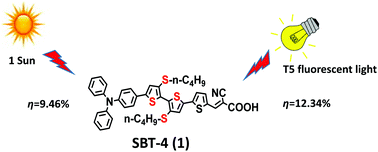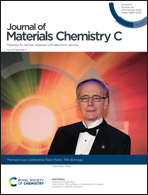Metal-free efficient dye-sensitized solar cells based on thioalkylated bithiophenyl organic dyes†
Abstract
A series of new metal-free organic dyes based on 3,3′-dithioalkyl-2,2′-bithiophene (SBT) organic chromophores was synthesized for use in dye-sensitized solar cells (DSSCs). Because S(alkyl)⋯S(thiophene) intermolecular interlocking renders the twist angle in the structure as <1°, the SBT core is almost flat, as evidenced by the single crystal, optical, and electrochemical data. Through structural modification of SBT π-linkers with different alkyl chains and conjugated thiophene units, significant chromophore aggregation and interfacial charge recombination can be inhibited. Among all the dyes synthesized, the optimized dye (having a high extinction coefficient of 1.3 × 104 cm−1 M−1 at 497 nm) with the co-adsorbent chenodeoxycholic acid (CDCA) reached a power conversion efficiency (η) of 9.46% under 1 sun (AM 1.5 G, 100 mW cm−2). After 1000 h of testing under 1 sun, a solar cell made with this dye and the co-adsorbent CDCA still maintained 88% of its initial efficiency, compared to 69% for a cell made with N719 dye. Moreover, when tested under a T5 fluorescent lamp of 2400 lux, the η of this dye with CDCA was 12.34%.

- This article is part of the themed collection: Celebrating Tobin Marks’ 75th Birthday


 Please wait while we load your content...
Please wait while we load your content...